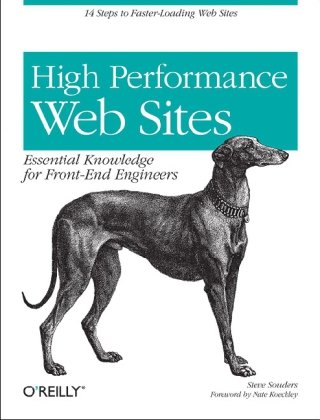

Most ebook files are in PDF format, so you can easily read them using various software such as Foxit Reader or directly on the Google Chrome browser.
Some ebook files are released by publishers in other formats such as .awz, .mobi, .epub, .fb2, etc. You may need to install specific software to read these formats on mobile/PC, such as Calibre.
Please read the tutorial at this link. https://ebooknice.com/page/post?id=faq
We offer FREE conversion to the popular formats you request; however, this may take some time. Therefore, right after payment, please email us, and we will try to provide the service as quickly as possible.
For some exceptional file formats or broken links (if any), please refrain from opening any disputes. Instead, email us first, and we will try to assist within a maximum of 6 hours.
EbookNice Team

Status:
Available4.6
30 reviews
ISBN-10 : 0596529309
ISBN-13 : 9780596529307
Author: Steve Souders
Want your web site to display more quickly? This book presents 14 specific rules that will cut 25% to 50% off response time when users request a page. Author Steve Souders, in his job as Chief Performance Yahoo!, collected these best practices while optimizing some of the most-visited pages on the Web. Even sites that had already been highly optimized, such as Yahoo! Search and the Yahoo! Front Page, were able to benefit from these surprisingly simple performance guidelines.The rules in High Performance Web Sites explain how you can optimize the performance of the Ajax, CSS, JavaScript, Flash, and images that you've already built into your site -- adjustments that are critical for any rich web application. Other sources of information pay a lot of attention to tuning web servers, databases, and hardware, but the bulk of display time is taken up on the browser side and by the communication between server and browser. High Performance Web Sites covers every aspect of that process.Each performance rule is supported by specific examples, and code snippets are available on the book's companion web site. The rules include how to:Make Fewer HTTP RequestsUse a Content Delivery NetworkAdd an Expires HeaderGzip ComponentsPut Stylesheets at the TopPut Scripts at the BottomAvoid CSS ExpressionsMake JavaScript and CSS ExternalReduce DNS LookupsMinify JavaScriptAvoid RedirectsRemove Duplicates ScriptsConfigure ETagsMake Ajax CacheableIf you're building pages for high traffic destinations and want to optimize the experience of users visiting your site, this book is indispensable.'If everyone would implement just 20% of Steve's guidelines, the Web would be adramatically better place. Between this book and Steve's YSlow extension, there's reallyno excuse for having a sluggish web site anymore.'-Joe Hewitt, Developer of Firebug debugger and Mozilla's DOM Inspector'Steve Souders has done a fantastic job of distilling a massive, semi-arcane art down to a set of concise, actionable, pragmatic engineering steps that will change the world of web performance.'-Eric Lawrence, Developer of the Fiddler Web Debugger, Microsoft Corporation
Rule 1: Make Fewer HTTP Requests
Image Maps
CSS Sprites
Inline Images
Combined Scripts and Stylesheets
Conclusion
Rule 2: Use a Content Delivery Network
Content Delivery Networks
The Savings
Rule 3: Add an Expires Header
Expires Header
Max-Age and mod_expires
Empty Cache vs. Primed Cache
More Than Just Images
Revving Filenames
Examples
Rule 4: Gzip Components
How Compression Works
What to Compress
The Savings
Configuration
Apache 1.3: mod_gzip
Apache 2.x: mod_deflate
Proxy Caching
Edge Cases
Gzip in Action
Rule 5: Put Stylesheets at the Top
Progressive Rendering
sleep.cgi
Blank White Screen
CSS at the Bottom
CSS at the Top
Flash of Unstyled Content
What’s a Frontend Engineer to Do?
Rule 6: Put Scripts at the Bottom
Problems with Scripts
Parallel Downloads
Scripts Block Downloads
Worst Case: Scripts at the Top
Best Case: Scripts at the Bottom
Putting It in Perspective
Rule 7: Avoid CSS Expressions
Updating Expressions
Working Around the Problem
One-Time Expressions
Event Handlers
Conclusion
Rule 8: Make JavaScript and CSS External
Inline vs. External
In Raw Terms, Inline Is Faster
Page Views
Empty Cache vs. Primed Cache
Component Reuse
Typical Results in the Field
Home Pages
The Best of Both Worlds
Post-Onload Download
Dynamic Inlining
Rule 9: Reduce DNS Lookups
DNS Caching and TTLs
Factors Affecting DNS Caching
TTL Values
The Browser’s Perspective
Internet Explorer
Firefox
Reducing DNS Lookups
Rule 10: Minify JavaScript
Minification
Obfuscation
The Savings
Examples
Icing on the Cake
Inline Scripts
Gzip and Minification
Minifying CSS
Rule 11: Avoid Redirects
Types of Redirects
How Redirects Hurt Performance
Alternatives to Redirects
Missing Trailing Slash
Connecting Web Sites
Tracking Internal Traffic
Tracking Outbound Traffic
Prettier URLs
Rule 12: Remove Duplicate Scripts
Duplicate Scripts—They Happen
Duplicate Scripts Hurt Performance
Avoiding Duplicate Scripts
Rule 13: Configure ETags
What’s an ETag?
Expires Header
Conditional GET Requests
Last-Modified Date
Entity Tags
The Problem with ETags
ETags: Use ’Em or Lose ’Em
ETags in the Real World
Rule 14: Make Ajax Cacheable
Web 2.0, DHTML, and Ajax
Web 2.0
DHTML
Ajax
Asynchronous = Instantaneous?
Optimizing Ajax Requests
Caching Ajax in the Real World
Yahoo! Mail
Google Spreadsheets
Deconstructing 10 Top Sites
Page Weight, Response Time, YSlow Grade
How the Tests Were Done
high performance wordpress
high performance web apps with fastapi pdf
high performance web apps with fastapi
high performing websites
high performance websites
Tags: High Performance, Web Sites, Essential Knowledge, Front End Engineers, Steve Souders